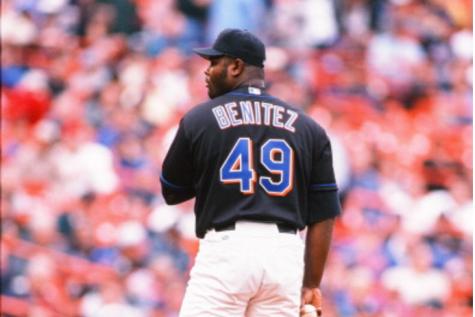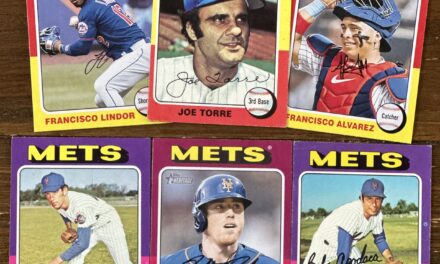
Waiting for Major League Baseball to come back — or, at least getting some kind of hope that it’ll be back this year — has led me to get real creative when searching through the FanGraphs database.
I mean, if you told me this time a year ago that I’d actually be spending time during April to talk about Armando Benitez‘s tenure with the New York Mets, I would’ve said you’re crazy. Yet, here we are.
My stroll down memory lane on FanGraphs reminded me that even though we’ve seen some dominant relief pitcher seasons in Queens, none have quite matched Benitez’s single-season production in 1999, his first with the organization. Many of us roll our eyes when we think about about his time with the Mets, and there are a couple reasons for that, like here and here. But hey, numbers don’t lie.
Making an Noteworthy First Impression
After spending his first five seasons with the Baltimore Orioles, the Mets acquired him in December 1998, and the not-very-liked right-hander succeeded in making a solid first impression from the standpoint of his season-long production.
After all, no Mets reliever has finished a single season with a higher fWAR than the 3.1 Benitez produced. The closest any New York reliever has gotten since then is Addison Reed in 2016 (2.4), and Seth Lugo this past season (2.3).
At this time in his career, Benitez tied his single-season career-high number for saves with 22 because he split those duties with John Franco before taking them over the following season. From the perspective of numbers, though, everything else looked impressive.
Through 78 innings of work (77 appearances), he posted career-best marks in ERA (1.85), strikeout rate (41.0%), strikeout-to-walk rate (27.9%), and home runs allowed per nine innings (0.46). That 1.85 ERA is among the 10 best performances in Mets history, and his 41.0% strikeout rate is still the best (nearly bested by Edwin Diaz‘s 39.0% in 2019).
With Benitez’s first campaign with New York coming as a 26-year-old, it wouldn’t have been outrageous to think he found something upon entering what is typically the prime years for a ballplayer — even if some of that success could’ve been from switching leagues.
(Mostly) Downhill From There
Not quite, you guys. I know — that’s just shocking based on how many of us feel about him whenever his name is brought up in conversation. Benitez’s save totals between 2000 and 2002 were impressive — 41, 43, and 33 — but there were some other alarming trends that took place, which is partially why we had to hold our breath in the ninth inning lots of nights.
From a cumulative value basis, the right-hander’s fWAR never got in the same vicinity as that 3.1 mark from 1999. Over the next three full seasons, it dipped down to 1.5, 0.3, and 1.0 (along with 0.5 through 49.1 innings with New York in 2003). As a hurler who could pump fastballs into the mid- and upper-90s on a regular basis, the more alarming trend — especially as a closer — was a precipitous drop in strikeout rate.
As mentioned previously, Benitez’s 41.0% strikeout rate in 1999 was not only the best in his career, but also the best single-season rate by a reliever in Mets history. At the time he did it, the 34.9% strikeout rate he posted in 2000 was the second-best mark in franchise history (it’s now third thanks to Diaz).
The drop continued rather significantly from there, as it was 29.1% in 2001 and 28.7% in 2002, followed by a 23.9% mark in 2003 during those 49.1 innings of work. Even though his walk rate didn’t necessarily spike over this period of time, it’s not like that aspect of his game was helping all that much, either (13.1%, 12.5%, 12.5%, 9.1%, and 11.5% each year of his Mets tenure).
1999 Was Benitez’s On-Field Crescendo
When taking a quick scan of Benitez’s career page on FanGraphs, it’s easy to see that for the most part, his 1999 performance was the outlier. He did set career-best marks for both saves (47) and ERA (1.29) in a single season in 2004 with the Florida Marlins, but his overall value, as measured by fWAR, didn’t hold a candle to what he did during that first season in Flushing.
Another way to put that 3.1-fWAR performance in just 78 innings in perspective would be like this:
— In the five seasons before 1999, Benitez accumulated 2.4 fWAR in 213.2 innings.
— In the nine seasons following 1999, Benitez accumulated 4.5 fWAR in 487.1 innings.
If we single out his time with the Mets specifically, it’s even more obvious that when using fWAR as the determining factor, we actually saw him at his best in a big-league uniform:
— Taking what I had above, he totaled 2.4 fWAR in 213.2 innings for the Orioles.
— In 347 innings pitched with New York, he produced 6.4 fWAR.
— In the 218.1 innings after he left the Mets, he produced 1.3 fWAR.
Armando Benitez is similar to John Olerud in the fact that he saved the best overall production of his career for his time in Queens. However, Benitez did it in such a “special” way that our memories of each player is drastically different from one another.















